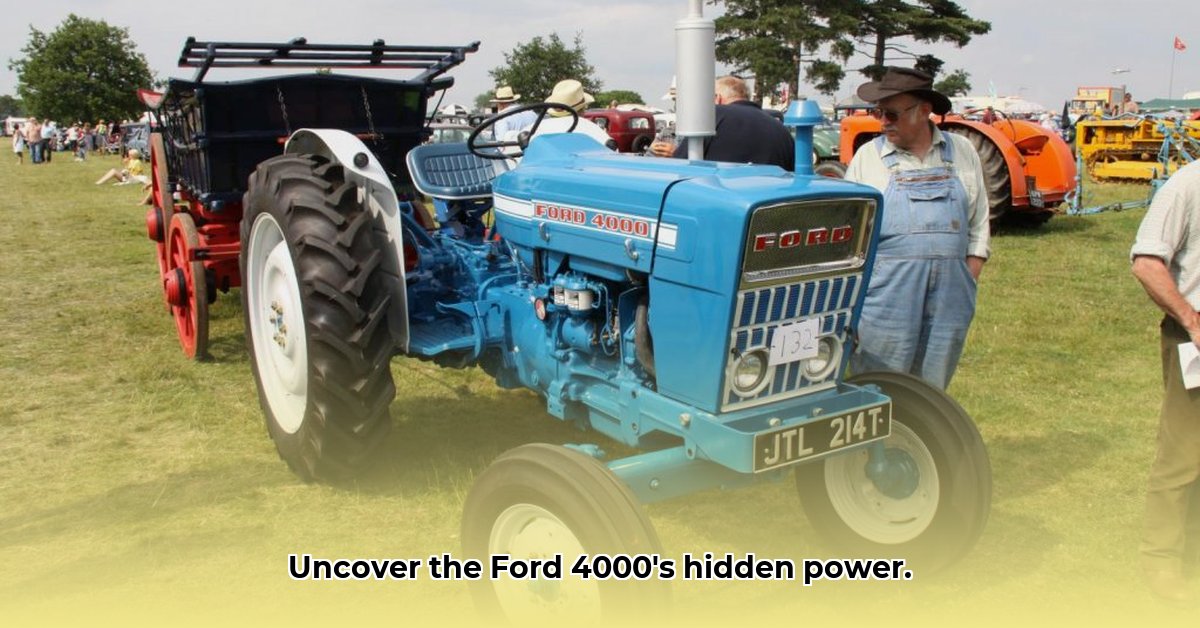
The Ford 4000 tractor, a stalwart of agricultural history, remains a popular choice for farmers and collectors alike. This comprehensive guide explores its specifications, historical context, and practical considerations for modern ownership. We'll uncover its strengths and weaknesses, providing a clear picture of this iconic machine. For more Ford tractor models, see this helpful resource.
Ford 4000 Tractor Specifications: A Detailed Overview
The Ford 4000's enduring appeal stems from its robust design and adaptable capabilities. Let's delve into its key specifications, comparing them to contemporary competitors and highlighting their impact on its overall performance.
Engine Power and Options: The Heart of the Machine
The Ford 4000 offered diverse engine options to cater to various needs and budgets. These included gasoline, diesel, and even LPG (Liquified Petroleum Gas) engines, all utilizing a reliable three-cylinder configuration. Engine displacements ranged from approximately 2.8 liters to 3.3 liters, generating horsepower outputs typically between 40 and 47 hp. This power output, while modest by today's standards, was competitive for its time. The choice of fuel type often impacted cost and availability for the farmer. Did this flexibility contribute to its widespread adoption? Research suggests that this versatility was a crucial factor in its market success.
Transmission and Drive: Smooth Operation and Terrain Handling
The Ford 4000 featured either an 8-speed or a 10-speed manual transmission, providing operators with the flexibility to adjust speed according to the task at hand. However, the tractor's two-wheel-drive system presented limitations, particularly in challenging terrain. Muddy or slippery conditions could significantly impede traction. This design limitation highlights a compromise between maneuverability, cost, and performance – a crucial consideration for farmers of the era. How did this influence its suitability for various farming operations? The choice ultimately depended on the specific needs and the type of terrain the farmer worked with.
Hydraulics and PTO: Powering Implements and Attachments
The Ford 4000's hydraulic system, though less sophisticated than modern counterparts, efficiently managed implements with a hydraulic fluid capacity of approximately 8 gallons. The independent power take-off (PTO) ensured smooth operation of attached machinery like mowers, balers, and other essential implements. The design of its PTO contributed significantly to its overall reliability – something that modern designs could still learn from. Yet, was the hydraulic responsiveness up to par with competing models? Comparisons with rivals reveal that hydraulic speed and reaction times were, in fact, a point of improvement opportunity.
Dimensions and Weight: Size and Maneuverability
The Ford 4000's dimensions were surprisingly compact for its era, allowing for maneuverability in smaller fields. Its weight, which varied slightly depending on configurations, ensured stability during operation. However, its relatively small 16-gallon fuel tank was often cited as a weakness, necessitating frequent refueling. This design limitation highlights the trade-offs inherent in balancing fuel efficiency, weight, and power during the tractor's design phase.
Ford 4000 Tractor Specifications: Summary Table
| Specification | Value | Notes |
|---|---|---|
| Engine | 2.8L - 3.3L Three-Cylinder | Gasoline, Diesel, or LPG options available; three-cylinder design typical of that era |
| Horsepower | 40-47 hp | Varied slightly based on engine type and methodology; relatively modest by today's standards |
| Transmission | 8-speed or 10-speed manual | Offered flexibility for various tasks |
| Hydraulic Capacity | ~8 gallons | Sufficient for many common implements |
| Fuel Tank Capacity | 16 gallons | Relatively small, requiring more frequent refueling |
| Drive Type | Two-Wheel Drive | Limited traction in adverse conditions |
| PTO | Independent | Enabled smooth operation of attached equipment |
| Brakes | Mechanical Wet Disc | Common design for tractors of this era |
Ford 4000 Tractor: Historical Context and Comparative Analysis
The Ford 4000, primarily produced between 1964 and 1975, represented a critical step in Ford's tractor lineage and broader agricultural technology. While a reliable choice for many farmers, its capabilities—particularly horsepower, traction, and hydraulic response—were limiting compared to modern tractors. Its enduring appeal makes it a fascinating study in agricultural engineering. How did its design balance affordability, durability, and performance in a changing market? Careful analysis helps us understand its success and limitations within its historical context.
Operational Considerations for Modern Owners
Owning a vintage tractor presents unique challenges. Sourcing spare parts can be more difficult than for newer models, and regular maintenance is paramount. Understanding the mechanical nuances of the Ford 4000 is crucial for safe and effective operation. Safety standards were different during its production, so extra care is needed. Is this trade-off between affordability and maintenance worth it? The answer depends on the owner's experience and resources.
Conclusion: Legacy and Enduring Appeal
The Ford 4000 tractor holds a special place in agricultural history. While its technology may be dated compared to modern machines, its robust build quality, simple design, and relative affordability contribute to its continued appeal. Its legacy resonates with farmers and collectors alike, as a testament to the enduring qualities of well-engineered machinery. This classic tractor serves as a valuable reminder of how technology has advanced the field of agriculture.